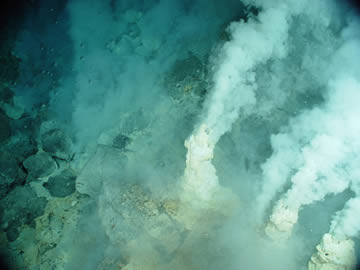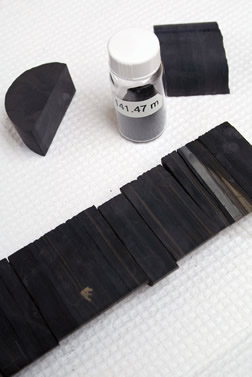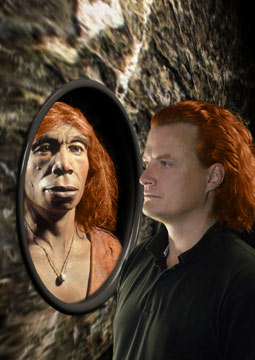|
HIGHLIGHTS — Ancient Life
2007 Highlights Home page >> Ancient Life Features >> Ancient Life Highlights
Oxygen takes hold
Ancient Life: Headline News Stories
Oxygen takes hold
 NOAA Office of Ocean Exploration, Bob Embley |
| Underwater volcanoes that gobble up oxygen dominated Earth before 2.5 billion years ago, preventing oxygen from building up in the atmosphere. |
Most of us take for granted the life-sustaining oxygen we breathe, yet Earth’s atmosphere wasn’t always so hospitable. Billions of years ago, Earth’s air was devoid of oxygen, preventing modern oxygen-dependent life from evolving. Why things suddenly changed sometime between 2.4 billion and 2.3 billion years ago is an extremely important question to those who study the origins of life. This year new research helped pinpoint more precisely how and when oxygen began to be seen in the atmosphere.
The chemical traces of the Great Oxidation Event — the sharp rise of oxygen in Earth’s atmosphere — are recorded in the geologic record of Earth’s oldest rocks. By studying a rock core from the Hamersley Basin in Western Australia, home to some of Earth’s most ancient rocks, two teams of researchers discovered a significant amount of oxygen in Earth’s oceans 50 million to 100 million years prior to the Great Oxidation Event.
 Arizona State University, Photo by Tim Trumble |
| This rock core from the Hamersley Basin in Western Australia provided researchers with evidence of oxygen on Earth 50 million to 100 million years before the Great Oxidation Event. |
One team, led by Ariel Anbar of Arizona State University in Tempe, looked at molybdenum, rhenium and uranium in marine sediments in the core dated to 2.5 billion years ago. The abundance of these metals in the oceans is tied to the presence of oxygen. When oxygen is present, for example, molybdenum levels are high because oxidation removes the metal from sulfide minerals. When oxygen is absent, however, molybdenum levels are low because the metal remains locked in the sulfide minerals. The high levels of these metals in the rock core suggest there must have been a significant, albeit small, amount of oxygen in at least Earth’s oceans, if not the atmosphere, the team reported Sept. 28 in Science. “We seem to have captured a piece of time before the Great Oxidation Event during which the amount of oxygen was actually changing — caught in the act, as it were,” Anbar said in a press statement.
Another team, led by Alan Kaufman of the University of Maryland in College Park, studied sulfur isotopes in the same section of the rock core and came to a similar conclusion. They found the earliest evidence of the sulfur cycle, in which oxygen plays a key role, suggesting at least some oxygen was present by at least 2.5 billion years ago.
But knowing when oxygen took hold in Earth’s atmosphere is only part of the story. Researchers are also interested in better understanding why oxygen accumulated when it did. Photosynthetic cyanobacteria, better known as blue-green algae, began producing oxygen at least 200 million years before the Great Oxidation Event, so one question that has bugged researchers is what happened to all that oxygen. The answer to that question may lie in volcanoes.
Prior to 2.5 billion years ago, submarine volcanoes dominated Earth. The carbon monoxide, methane and hydrogen sulfide released by these volcanoes prevented the oxygen produced by the cyanobacteria from accumulating in the atmosphere, according to Lee Kump of Pennsylvania State University in University Park and Mark Barley of the University of Western Australia in Crawley (see Geotimes, November 2007). “These [gases] react vigorously with oxygen and essentially strip it from the ocean,” Kump told Geotimes in November. “Then these gases escape into the atmosphere and mop up any oxygen that might be lingering there.”
Kump and Barley amassed a large dataset of volcanic activity over time and found that there was a big shift from submarine volcanoes to terrestrial volcanoes about 2.5 billion years ago, coinciding with the formation of continental crust, the two reported Aug. 30 in Nature. Unlike submarine volcanoes, gases emitted from land volcanoes don’t react with oxygen, allowing it to build up in the atmosphere and paving the way for the evolution of life. This story is a great example of how life and the environment co-evolve, Kump said.
Links:
“Volcanoes may have swallowed early Earth’s oxygen,” Geotimes, November 2007
Ancient Life: Headline News Stories
 Image courtesy of Michael Hofreiter and Kurt Fiusterweier/MPG EVA |
Little red-headed Neanderthal
Fossils can only tell us so much about the Neanderthals. Now genetic analyses are helping researchers paint a more detailed picture of what our ancient cousins looked like. In modern humans, fair skin and red hair likely result from a low functioning version of the pigment gene MC1R. Researchers who extracted DNA from two Neanderthals found a mutation in the MC1R gene that hasn’t been seen in modern humans. By inserting the Neanderthal gene into human cells, the researchers discovered the unique mutation lowered the gene’s function, suggesting Neanderthals with the mutation might have had a similar complexion to modern-day redheads.
Lalueza-Fox et al., Science, Oct. 26, 2007.
Oldest modern human in China
Researchers found the remains of the oldest-known modern human in China. Dated to between 35,500 and 33,500 radiocarbon years, the fossils help fill in the gaps of the sparse record of early modern humans in East Asia. The bones look modern, but some features of the teeth and legs are primitive, suggesting modern humans might have mated with more “archaic” species, such as Neanderthals, after leaving Africa, researchers claim.
Shang et al., Proceedings of the National Academy of Sciences, April 17, 2007.
The first fish fry
New evidence from the southern coast of South Africa shows modern humans exploited marine resources such as shellfish 164,000 years ago, about 40,000 years earlier than previously thought. Researchers also found tiny blades that indicate humans made complex tools such as spears or darts, and pigmented artifacts suggest humans were capable of symbolic behavior. Being a glacial period, Africa was quite dry at the time, so utilizing coastal resources may have allowed humans to survive the harsh environment.
Marean et al., Nature, Oct. 18, 2007.
Talk like a Neanderthal
Paleoanthropologists have debated for years whether or not Neanderthals had language, often basing their arguments on Neanderthal anatomy. Now researchers have genetic evidence. FOXP2 is the only known gene that’s been tied to speech and language ability. Humans have two important mutations that make their version of the gene different from chimpanzees, and presumably these changes enable language capability. By analyzing the Neanderthal FOXP2 gene recovered from fossils in Spain, researchers found Neanderthals also have these same mutations. Though not definitive evidence that Neanderthals talked like us, researchers say, it does show it might have been possible.
Krause et al., Current Biology, Oct. 18, 2007.
Dinos on the move
In Spain’s Cameros Basin, researchers found the first conclusive evidence that dinosaurs could swim. The pattern of six asymmetrical pairs of footprints along with fossilized scratch marks and ripple marks are indicative of an animal floating against the current, clawing sediments as it swam in 3-meter-deep water. And in Montana, researchers discovered a new species of dinosaur entombed in a burrow. Features of the snout, shoulder and pelvis show the dinosaur was a digger. The presence of an adult and two juveniles in the burrow suggests these dinosaurs dug burrows to rear their young, more evidence that some dinosaurs cared for their offspring, researchers say.
Ezquerra et al., Geology, June 2007; Varricchio et al., Proceedings of the Royal Society B, June 7, 2007.
T-rex — one big chicken?
Fossilized bones generally don’t contain organic material, especially fossils that are millions of years old. But researchers studying a 68-million-year-old Tyrannosaurus rex leg bone managed to extract collagen proteins that provide genetic evidence of the link between dinosaurs and birds. By comparing the T-rex’s collagen sequences with those of modern animals, the researchers found the dinosaur’s sequences matched most closely with modern chickens, but also matched well with frogs and newts.
Geotimes online, Web Extra, April 16, 2007; Schweitzer et al., Science, April 13, 2007.
Big teeth, wimpy bite
Based on computer modeling of bite force biomechanics, researchers learned that the saber-toothed cat Smilodon fatalis might have looked ferocious with its long, dagger-like canines, but its bite wasn’t so fierce. The model shows the ancient cat’s bite was only one-third as powerful as a modern lion’s bite. Researchers think the saber-toothed cat probably used its heavily muscled body to wrestle prey to the ground before delivering a fatal bite to the throat.
McHenry et al., Proceedings of the National Academy of Sciences, Oct. 9, 2007.
Early reptiles leave their mark
Newly discovered fossilized footprints in Canadian sea cliffs record the earliest evidence of reptiles, suggesting they evolved several million years earlier than previously thought. About 315 million years ago, tiny reptiles strolled across the muddy bottom of a dry riverbed. Researchers determined the prints belonged to reptiles and not amphibians based on the imprints of scales and five fingers.
Falcon-Lang et al., Journal of the Geological Society, London, Dec. 1, 2007.
Say what?
Studying a group of 260-million-year-old reptiles from Russia, researchers found the earliest evidence of the modern ear. Previously, researchers believed modern hearing in land animals evolved much more recently, about 200 million years ago, just prior to the rise of dinosaurs. Comparative analyses, however, showed these early reptiles probably heard just as well as modern lizards. Researchers speculate good hearing in these reptiles might have been an adaptation to a nocturnal lifestyle, where hearing prey and vocally communicating with other would have been useful.
Müller and Tsuji, PLoS One, Sept. 12, 2007.
A tiny war preserved in amber
It turns out chemical warfare is hardly a modern invention. A tiny beetle preserved in amber for nearly 100 million years has provided researchers with the earliest evidence of chemical defense. The beetle was in the process of emitting a chemical repellant when it became stuck in sap that would eventually fossilize into amber. The amber also contains antennae from a larger insect, the likely target of the beetle’s chemical weapon.
Poinar et al., Journal of Chemical Ecology, August 2007.
Ancient DNA reveals Greenland’s past
Although covered by a thick layer of ice today, Greenland was once actually green. By studying ice cores, researchers managed to obtain DNA of plants and insects preserved in the ice for nearly half a million years. Researchers used these plants and insects to reconstruct Greenland’s environment, which they found to be similar to conifer forests of modern Sweden and Eastern Canada.
Willerslev et al., Science, July 6, 2007.

 Subscribe
Subscribe


